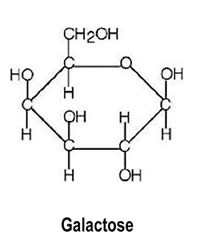Difference between Glucose and Galactose
Key Difference: The term “glucose” is derived from the Greek, “glukus”, meaning “sweet”. Glucose is also known as D-glucose, dextrose, or grape sugar is found in plants and it is a byproduct of photosynthesis and fuels for cellular respiration. Glucose is used as energy by living organisms. Galactose is a monosaccharide sugar that is less sweet compared to glucose. It is a C-4 epimer of glucose.
Sugars are categorized as carbohydrates, which are a group of compounds made up of carbon, hydrogen and oxygen. Carbohydrates, and in turn sugars, are the source of chemical energy for living organisms, including humans. Sugars are categorized as monosaccharide, disaccharides and polysaccharides. Monosaccharides are the simplest carbohydrate type, composed of a single molecule. These include glucose, galactose, and fructose. Disaccharides are made up of two molecules. The table sugar, also known as sucrose, most commonly used by humans, is a type of disaccharide. Other disaccharides include maltose and lactose.

The term “glucose” is derived from the Greek, “glukus”, meaning “sweet”. The suffix ‘-ose’ denotes that it is a sugar. Glucose is also known as D-glucose, dextrose, or grape sugar is found in plants and it is a byproduct of photosynthesis and fuels for cellular respiration. Photosynthesis is the process where the plants produce their own food using carbon dioxide, water and sunlight. It is a dietary carbohydrate that is directly absorbed in the bloodstream during digestion. In living organisms such as humans, plants and animals, glucose is used as body fuel and energy. Excess glucose is stored in the form of glycogen in animals and humans and in the form of starch in plants.
Glucose is an important part an organism’s diet, which is used by an organism for growth and development. Use of glucose may be by either aerobic respiration or anaerobic respiration, or fermentation. In humans, it is key source of energy and can be acquired from carbohydrates enriched foods such as bread, pasta, potatoes, and sweets. In plants, glucose is found in the sap as starch, while excess glucose is stored in the seeds and roots for later use.
 Though glucose is most commonly found in the form of food, it can also be found in the form of tablets, powder or liquid. Glucose in the form of dextrose is given to a person who suffers from a condition known as diabetes. Diabetes is a disease where a human’s body stops processing insulin which converts glucose into energy. In industry, glucose is used as a precursor to make vitamin C, citric acid, gluconic acid, bio-ethanol, polylactic acid and sorbitol. The presence of sufficient levels of glucose in the blood stream is the primary mechanism that controls the feelings of hunger and the desire for more food.
Though glucose is most commonly found in the form of food, it can also be found in the form of tablets, powder or liquid. Glucose in the form of dextrose is given to a person who suffers from a condition known as diabetes. Diabetes is a disease where a human’s body stops processing insulin which converts glucose into energy. In industry, glucose is used as a precursor to make vitamin C, citric acid, gluconic acid, bio-ethanol, polylactic acid and sorbitol. The presence of sufficient levels of glucose in the blood stream is the primary mechanism that controls the feelings of hunger and the desire for more food.
Galactose is a monosaccharide sugar that is less sweet compared to glucose. It is a C-4 epimer of glucose. Epimers are diastereomers that differ in configuration of only one stereogenic center. Diastereomers are a class of stereoisomers. The galactose in the body is usually a result of a polymer galactin which converts into galactose through hydrolysis. It has four isomers and is a hexose monosaccharide. It differs from glucose due to the way the –OH is located in the fourth carbon. When combined with glucose, it forms disaccharide lactose. This is the lactose that is found in dairy products. Galactose metabolism, the process where galactose is converted into glucose is done by three enzymes in the Leloir pathway.
|
|
Glucose |
Galactose |
|
Molecular formula |
C6H12O6 |
C6H12O6 |
|
Molar mass |
180.16 g mol−1 |
180.156 g mol−1 |
|
Structure |
Glucose can exist in both open and cyclic form. It has five hydroxyl groups that are arranged in a specific way along the six-carbon backbone. |
Galactose can exist in both open chain and cyclic form. In the open chain form, galactose has as a carbonyl at the end of the chain. It has four isomers. |
|
Sources |
Juices, fruits, sugars, etc. |
Gums, sugar beets, dairy products, gums and mucilages. |
|
Melting point |
α-D-glucose: 146 °C β-D-glucose: 150 °C |
167 °C, 440 K, 333 °F |
|
Broken down |
Glucose is broken down in the body and then used as body fuel and energy. |
Galactose cannot be easily broken down. It is goes through the Leloir pathway in the body. |
Image Courtesy: encyclopedia2.thefreedictionary.com, omegafields.com









Comments
gud
m
Tue, 09/23/2014 - 05:14
Add new comment